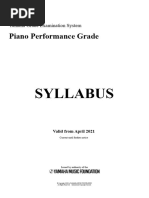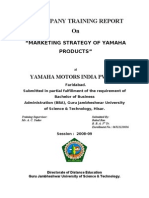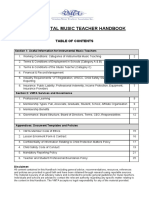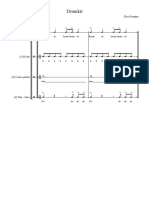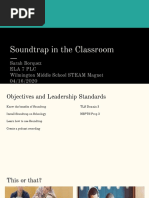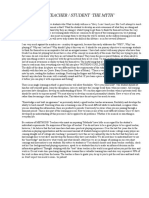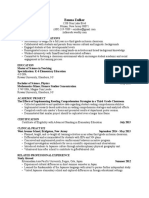Lesson Plan Music
Lesson Plan Music
Uploaded by
api-550031675Copyright:
Available Formats
Lesson Plan Music
Lesson Plan Music
Uploaded by
api-550031675Original Title
Copyright
Available Formats
Share this document
Did you find this document useful?
Is this content inappropriate?
Copyright:
Available Formats
Lesson Plan Music
Lesson Plan Music
Uploaded by
api-550031675Copyright:
Available Formats
Lesson Focus: The Arts Learning Area/Strand: Year Level: 3-4 Duration: 3 hours
Music
Overview:
Teaching music to young children can be challenging, however this resource helps
students find their desire to learn through fun activities. The students will become music
composer using their previously constructed Chinese rattle drum.
The learners will be split into small groups and complete 3x one hour lessons.
This resource introduces students into Music through a fun, interactive YouTube video.
This video assists the learners in developing a rhythmic feel to simple music notes. They
are also encouraged to clap along with the notes and read the composition.
Another YouTube video has been included in this resource to help students comprehend
how this instrument is used in cultural dances.
The Year 3 HASS unit of exploring places near and far is integrated into these activities to
follow on from the previous Visual arts resource.
Individually, students will attempt to create their own short music composition. Following
on, in small groups student will create their own 16 beat composition and choreograph a
dance.
Prior Knowledge of learners
Students know the elements of Music Art and Design
Students require prior experience with the following Years P-2 Band:
At Year 3-4 level the elements of music and clapping using ta, ta, ti-ti, ta will be a familiar concept.
By the end of Year 2, students communicate about the music they listen to, make and
perform and where and why people make music.
Students improvise, compose, arrange and perform music.
They demonstrate aural skills by staying in tune and keeping in time when they sing and
play. (ACARA, 2016).
Lesson Objective/s
By the end of this lesson, students should be able to:
Identify the different musical elements and understand how they can be used differently
to communicate different moods and effects. This includes dynamics, pitch and rhythm
patterns.
Develop aural skills through exploring, imitating and recognising elements of music.
Explore different music used in cultures other than Australian.
Play the music instrument with control through improvising rhythmic accuracy, pitch and
dynamics.
Create, perform and record compositions that demonstrate an organisation of sounds,
silences, tempo and volume.
Evidence of learning: At the end of this activity students will:
Develop aural skills by exploring, imitating and recognising elements of music including
dynamics, pitch and rhythm patterns in celebratory and commemorative songs.
Play instruments and improvise music such as rhythm, pitch, dynamics and form in a
range of pieces.
Key Questions for Years 3 and 4
Does music help us to understand the past, people and places?
What are some stories you have heard through music? How is the rhythm, pitch and
expression used differently to convey this message? How did this music make you feel and
why? – ask these questions to a few different students.
How else can musicians use rhythm, pitch and expression to communicate an idea that we
haven’t already said?
What do you like the most about music?
Is there music that reminds you of something in your life?
What have you learned by listening to music?
Links to Curriculum
Develop aural skills by exploring, imitating and recognising elements of music including
dynamics, pitch and rhythm patterns (ACAMUM084)
Practice singing, playing instruments and improvising music, using elements of music
including rhythm, pitch, dynamics and form in a range of pieces, including in music from
the local community (ACAMUM085)
Create, perform and record compositions by selecting and organising sounds, silence,
tempo and volume (ACAMUM086)
Identify intended purposes and meanings as they listen to music using the elements of
music to make comparisons, starting with Australian music, including music of Aboriginal
and Torres Strait Islander Peoples (ACAMUR087)
Cross-Curriculum Focus and Links:
HASS: Exploring places near and far
The location of Australia’s neighbouring countries and the diverse characteristics of their
places (ACHASSK067)
The similarities and differences between places in terms of their type of settlement,
demographic characteristics and the lives of the people who live there, and people’s
perceptions of these places (ACHASSK069)
Mathematics: Numeracy. Estimating and calculating with whole numbers.
Understand and use numbers in context
Recognise and use patterns and relationships
Describe, continue, and create number patterns resulting from performing addition or
subtraction subtraction (ACMNA060)
Resources
YouTube Video: https://www.youtube.com/watch?v=WEOTsPUUvsY
YouTube Video: https://www.youtube.com/watch?v=9gM6HK2xRmQ&t=24s
Rhythmic Invention Worksheet
16 count composition worksheet: https://www.teacherspayteachers.com/Product/Two-
Four-Six-Eight-a-Music-Lesson-for-Rhythm-and-Melody-168867?
st=f488c29a27baf0eeed3f200cb60365e6
Differentiation strategies
Extension questions - gives a vehicle for more academically able students to progress to
challenge themselves and further develop their musical knowledge.
Students with require more assistance and find the task difficult will be grouped with
more confident and academically able students.
Read through the worksheets to the whole class for those students who have difficulty
comprehending musical tasks.
Lesson Introduction Students will watch ‘Rhythm Play Along: Easy’ and carefully listen. This
Introducing video will be played a second time for students to sing and clap along to
the topic the rhythm.
Engagement https://www.youtube.com/watch?v=WEOTsPUUvsY
of the learners Watch this video of a musician playing the piano then elicit a whole class
discussion.
https://www.youtube.com/watch?v=7Ae5d1w9xtY
Class Discussion/Targeted Questions for students:
• Does music help us to understand the past, people and places?
• What are some stories you have heard through music? How is
the rhythm, pitch and expression used differently to convey this
message? How did this music make you feel and why? – ask these
questions to a few different students.
• How else can musicians use rhythm, pitch and expression to
communicate an idea that we haven’t already said?
• What do you like the most about music?
• Is there music that reminds you of something in your life?
• What have you learned by listening to music?
Lesson Body Activity 1: Individual
Delivering the • Give the students the Rhythmic Invention worksheet. Read
content through the questions together to ensure students understand what is
through expected of them.
specific • Instruct them students to complete this worksheet individually.
strategies • Hand out the 16 count composition worksheet and focus the
students attention on the example at the top of the page.
• After student have closely analysed the example, instruct them
to complete the next part of the worksheet by themselves.
Activity 2: Small groups
Display the YouTube recording that demonstrates how a Chinese Rattle
drum is used to create music.
https://www.youtube.com/watch?v=9gM6HK2xRmQ&t=24s
• Split the students into small groups of three or four. Give each
group a blank gride with 16 squares for them to write a 16-count
composition.
• The students will refer to the previous 16 count compositions
completed by their group members and work together to combine all of
their ideas into one new composition.
Lesson Conclusion Activity 3: Small Groups
Concluding • In the same small groups from the previous activity, students will
activities perform their 16 count composition.
Summarising • This may require sufficient practice in order for the group to
the lesson synchronise their music.
• They will perform the 16-count composition together with their
Chinese rattle drums.
• Each group will record their composition on an iPad. This will be
used in the next set of planned activities.
You might also like
- Music, Learning, and Behavior:: A Case For Mental StretchingNo ratings yetMusic, Learning, and Behavior:: A Case For Mental Stretching22 pages
- Big Brain, Little Hands:: How to Develop Children’s Musical Skills Through Songs, Arts, and CraftsFrom EverandBig Brain, Little Hands:: How to Develop Children’s Musical Skills Through Songs, Arts, and CraftsNo ratings yet
- Glossary of Editing Terms: Writing For Journalists - Wynford Hicks, Sally Adams, Harriet Gilbert, Tim HolmesNo ratings yetGlossary of Editing Terms: Writing For Journalists - Wynford Hicks, Sally Adams, Harriet Gilbert, Tim Holmes20 pages
- Philosophy of Time Travel Phil10125 Course GuideNo ratings yetPhilosophy of Time Travel Phil10125 Course Guide19 pages
- VMTA - Music Teacher Handbook - V4 - 16 October 2019 - CURRENTNo ratings yetVMTA - Music Teacher Handbook - V4 - 16 October 2019 - CURRENT29 pages
- General Music: Kindergarten: Standard 1.0 SingingNo ratings yetGeneral Music: Kindergarten: Standard 1.0 Singing7 pages
- Christopher Pappas Distance Music Education100% (3)Christopher Pappas Distance Music Education13 pages
- Colin O'Brien and Dalia Montiel Instrument Music Lesson PlanNo ratings yetColin O'Brien and Dalia Montiel Instrument Music Lesson Plan2 pages
- Music Articles: Basic Practicing Techniques From Beginning To Advanced Level100% (1)Music Articles: Basic Practicing Techniques From Beginning To Advanced Level6 pages
- History of Motown (High School) : RationaleNo ratings yetHistory of Motown (High School) : Rationale6 pages
- Late 1950's To Mid 1970's: by Tom MunnoNo ratings yetLate 1950's To Mid 1970's: by Tom Munno10 pages
- Integrating Technology Into The 2nd Grade Music Curriculum 1No ratings yetIntegrating Technology Into The 2nd Grade Music Curriculum 149 pages
- Music 670 Elementary Teaching Unit Concept: Syncopation 4 Grade Jessica BrummelNo ratings yetMusic 670 Elementary Teaching Unit Concept: Syncopation 4 Grade Jessica Brummel51 pages
- Glendale High School AP-Music-Theory SYLLABUSNo ratings yetGlendale High School AP-Music-Theory SYLLABUS6 pages
- Edwin Gordon - All About Audiation and Music AptitudesNo ratings yetEdwin Gordon - All About Audiation and Music Aptitudes4 pages
- Rehearsal Technique/Rehearsal Etique!e: Be Present and On TimeNo ratings yetRehearsal Technique/Rehearsal Etique!e: Be Present and On Time2 pages
- Us Army Music Course - Nonharmonic Tones Mu1715100% (1)Us Army Music Course - Nonharmonic Tones Mu171542 pages
- Singing Music Lesson Plan Olivia Najera and Chelsey KemtponNo ratings yetSinging Music Lesson Plan Olivia Najera and Chelsey Kemtpon4 pages
- 18 The Cardiovascular System - The Heart PDFNo ratings yet18 The Cardiovascular System - The Heart PDF33 pages
- John Ray Felix - 01 - 21st Century Education ActivityNo ratings yetJohn Ray Felix - 01 - 21st Century Education Activity3 pages
- Hammodaand Foli 2024 Digital Competence Frameworkfor LearnersNo ratings yetHammodaand Foli 2024 Digital Competence Frameworkfor Learners26 pages
- Transformative Pedagogy For Peace-Building: A Guide For Teachers100% (2)Transformative Pedagogy For Peace-Building: A Guide For Teachers69 pages
- ADEC - Dar Al Uloom Private School 2014 2015No ratings yetADEC - Dar Al Uloom Private School 2014 201512 pages
- Section - Li Pedagogy Concerns: Module 8 - Pedagody of EVS - Indd 229 19-08-2019 13:27:17No ratings yetSection - Li Pedagogy Concerns: Module 8 - Pedagody of EVS - Indd 229 19-08-2019 13:27:1727 pages
- Year: Date: Subject: Day: Theme: Topic: Time: Duration: Number of Students: Level of ProficiencyNo ratings yetYear: Date: Subject: Day: Theme: Topic: Time: Duration: Number of Students: Level of Proficiency2 pages
- Storytelling As A Tool For English Classes With Young Learners: A Literature ReviewNo ratings yetStorytelling As A Tool For English Classes With Young Learners: A Literature Review9 pages
- Readiness of The Criminology Graduates in Taking The Criminologist Licensure ExaminationNo ratings yetReadiness of The Criminology Graduates in Taking The Criminologist Licensure Examination12 pages
- Republic of The Philippines Department of Education Region VII CEBU Cebu ProvinceNo ratings yetRepublic of The Philippines Department of Education Region VII CEBU Cebu Province32 pages
- TEACHERS GUIDE-GR-8-MEd - TG - G08 - EN - 03-Oct - DigitalNo ratings yetTEACHERS GUIDE-GR-8-MEd - TG - G08 - EN - 03-Oct - Digital94 pages
- Professional Framework For English Teachers 2020: State of Israel Ministry of Education English InspectorateNo ratings yetProfessional Framework For English Teachers 2020: State of Israel Ministry of Education English Inspectorate63 pages
- Music, Learning, and Behavior:: A Case For Mental StretchingMusic, Learning, and Behavior:: A Case For Mental Stretching
- Big Brain, Little Hands:: How to Develop Children’s Musical Skills Through Songs, Arts, and CraftsFrom EverandBig Brain, Little Hands:: How to Develop Children’s Musical Skills Through Songs, Arts, and Crafts
- Glossary of Editing Terms: Writing For Journalists - Wynford Hicks, Sally Adams, Harriet Gilbert, Tim HolmesGlossary of Editing Terms: Writing For Journalists - Wynford Hicks, Sally Adams, Harriet Gilbert, Tim Holmes
- VMTA - Music Teacher Handbook - V4 - 16 October 2019 - CURRENTVMTA - Music Teacher Handbook - V4 - 16 October 2019 - CURRENT
- Colin O'Brien and Dalia Montiel Instrument Music Lesson PlanColin O'Brien and Dalia Montiel Instrument Music Lesson Plan
- Music Articles: Basic Practicing Techniques From Beginning To Advanced LevelMusic Articles: Basic Practicing Techniques From Beginning To Advanced Level
- Integrating Technology Into The 2nd Grade Music Curriculum 1Integrating Technology Into The 2nd Grade Music Curriculum 1
- Music 670 Elementary Teaching Unit Concept: Syncopation 4 Grade Jessica BrummelMusic 670 Elementary Teaching Unit Concept: Syncopation 4 Grade Jessica Brummel
- Edwin Gordon - All About Audiation and Music AptitudesEdwin Gordon - All About Audiation and Music Aptitudes
- Rehearsal Technique/Rehearsal Etique!e: Be Present and On TimeRehearsal Technique/Rehearsal Etique!e: Be Present and On Time
- Singing Music Lesson Plan Olivia Najera and Chelsey KemtponSinging Music Lesson Plan Olivia Najera and Chelsey Kemtpon
- How To Music Major: What to Expect Your Freshman YearFrom EverandHow To Music Major: What to Expect Your Freshman Year
- John Ray Felix - 01 - 21st Century Education ActivityJohn Ray Felix - 01 - 21st Century Education Activity
- Hammodaand Foli 2024 Digital Competence Frameworkfor LearnersHammodaand Foli 2024 Digital Competence Frameworkfor Learners
- Transformative Pedagogy For Peace-Building: A Guide For TeachersTransformative Pedagogy For Peace-Building: A Guide For Teachers
- Section - Li Pedagogy Concerns: Module 8 - Pedagody of EVS - Indd 229 19-08-2019 13:27:17Section - Li Pedagogy Concerns: Module 8 - Pedagody of EVS - Indd 229 19-08-2019 13:27:17
- Year: Date: Subject: Day: Theme: Topic: Time: Duration: Number of Students: Level of ProficiencyYear: Date: Subject: Day: Theme: Topic: Time: Duration: Number of Students: Level of Proficiency
- Storytelling As A Tool For English Classes With Young Learners: A Literature ReviewStorytelling As A Tool For English Classes With Young Learners: A Literature Review
- Readiness of The Criminology Graduates in Taking The Criminologist Licensure ExaminationReadiness of The Criminology Graduates in Taking The Criminologist Licensure Examination
- Republic of The Philippines Department of Education Region VII CEBU Cebu ProvinceRepublic of The Philippines Department of Education Region VII CEBU Cebu Province
- TEACHERS GUIDE-GR-8-MEd - TG - G08 - EN - 03-Oct - DigitalTEACHERS GUIDE-GR-8-MEd - TG - G08 - EN - 03-Oct - Digital
- Professional Framework For English Teachers 2020: State of Israel Ministry of Education English InspectorateProfessional Framework For English Teachers 2020: State of Israel Ministry of Education English Inspectorate

